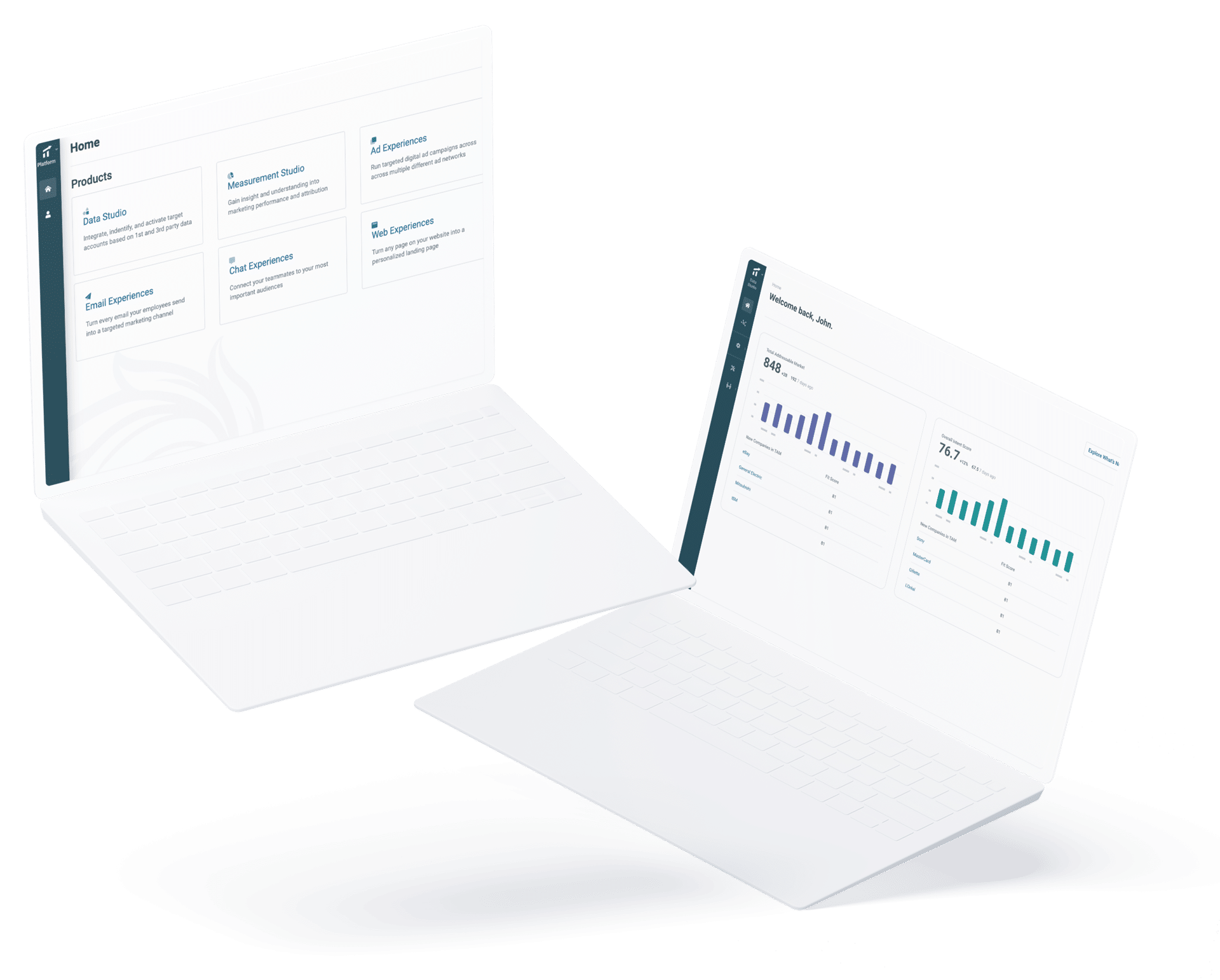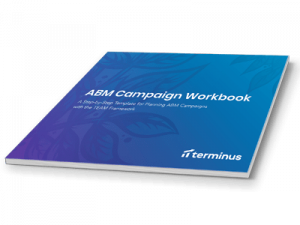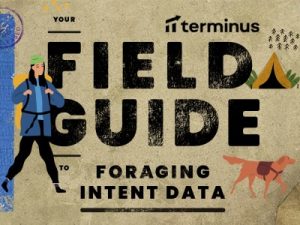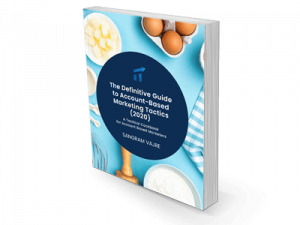Account Based Marketing vs Inbound Marketing: 2021-2022 Trends Report
Generating as many leads as possible is no longer a top priority. Targeted, efficient marketing to prospects AND customers is now the main focus. See how else ABM compares to inbound marketing in this new trends report.


Terminus ABM:The Perfect Complement to Your Inbound Marketing Strategy
Terminus gives marketing teams the data they need to understand who their next customers are, all the channels they need to engage them, and customizable reporting and attribution to prove their impact.

ABM Campaign Workbook for Inbound Marketing Ideas
Access it here
Field Guide: How to Use Intent Data for Key Account Marketing
Read more
ABM Cookbook: Ideas, Inspiration, and Recipes for Personalized Inbound Marketing
DownloadAccount Based Marketing vs Inbound Marketing
ABM and inbound marketing are not mutually exclusive. In fact, most of the best campaigns will use account-based marketing and inbound marketing together. It comes down to what works best for a B2B business. HubSpot is an excellent example of this; they specialize in inbound marketing software but also incorporate more ABM resources, training, and features inside of their platform. Teams can do both marketing strategies in a way in which both sides complement each other rather than being in competition.
To understand account based marketing vs inbound marketing, we need to look at the ways in which they are similar and in which they differ. Taking a look at HubSpot inbound marketing and account based marketing HubSpot lessons can help. The account based marketing HubSpot academy has a lot of information to offer for those who want to know more in-depth and the HubSpot Academy ABM also provides some excellent examples.
Both account based marketing and inbound marketing are focused on pulling in customers who are already interested in a product. HubSpot buying roles, for instance, dig deep into information accessible to find those who are likely to be interested in a product or a service. But account based marketing is focused on personalization and one-on-one communications and engagements, while inbound marketing is more focused on just bringing leads in.
When used together, inbound marketing can bring in leads while account based marketing can be used to better score them. While companies do want to still focus on quality (rather than using “spray and pray” tactics), bringing in a large number of leads can still be valuable if they can be appropriately scored. The better the scoring, the better the end results.
ABM Marketing
What is ABM marketing and what are some account based marketing tools? If you look at the trends, you’ll find that account based marketing 2019 really exploded, yet ABM marketing can always be viewed as one of the oldest forms of marketing. Account based marketing companies have existed for as long as marketing has — it’s a form of marketing that tracks customer interactions and customizes itself to each unique customer. But there was a gap during which account based marketing wasn’t really feasible because companies were instead trying to simply connect with as many people as possible, under generic circumstances.
The easiest way to understand account based marketing for dummies is to take a look at examples. Sending out a newsletter to previous customers based on the products they’ve purchased in the past is account based marketing. A bulletin or billboard is not account based marketing. There are many benefits of account based marketing: it makes customers feel valued, learns what customers want, and reduces costs because all marketing efforts are directed to those who are already interested.
When looking at account based marketing tactics 2019 to account based marketing tactics 2020, you’ll find that the influence on account based marketing has grown because so many consumers have moved to the internet. Consumers are inundated with marketing and want to see the marketing that’s most relevant to them. There are many more ABM solutions today and many of them have greater features available. ABM solutions make it possible to automate many forms of account based marketing, collecting information from customers, and customizing the marketing on-the-fly.
It’s because of these digital platforms that ABM is now possible. Cloud-based, digital ABM platforms have the resources and technology necessary to help marketers get the results they want within even leaner budgets. But because there are many ABM solutions today, it can also be harder to select the right one.
What is Inbound Marketing?
What is inbound marketing? Compared to ABM, it’s much broader. Inbound marketing is a method of bringing customers to the business who are interested in the business, rather than just trying to bring in random leads, or conducting outbound marketing (connecting with people directly). Inbound marketing draws people in by having interesting and unique media and content that an audience interested in products and services would be interested in. For instance, a real estate company would want to present information on homeownership and how to become a homeowner.
The importance of inbound marketing relates to ensuring that marketing dollars are spent in the right place. In this case, marketing spend is directly focused on those who are already within a target audience; an audience potentially very interested in the products and services. Some inbound marketing examples include:
- Creating a social media account, such as an Instagram account, that features products and services very similar to one’s own product and service, thereby drawing in an audience that’s likely to be interested in.
- Creating a YouTube channel that involves hobbies or activities that are similar to a product or service, which would also make it more likely that the audience would be exposed to what you’re selling.
- Holding classes or seminars that are adjacent to the products and services that you provide, such as business and finance classes being held by a tax or bookkeeping service.
When paired with ABM, these inbound marketing examples become much more powerful. ABM can track interactions customers have had with a business in the past, thereby making future marketing more effective and more personal.
Inbound Marketing Strategy
How do you develop an inbound marketing strategy? You can start with an inbound marketing certification. HubSpot provides certifications, training, classes, courses and tools to help develop an inbound marketing strategy. Many of these inbound marketing tools can help marketers familiarize themselves with the strategies behind inbound marketing as well as the most important metrics. By educating yourself on inbound marketing and ABM strategies, you will be able to best see how they can be integrated together. The top recommended sources of information are HubSpot and SmartBug Media.
Apart from inbound marketing certification and inbound marketing tools, individuals can take a look at the inbound marketing strategy of competitors. Some great examples of inbound marketing strategy include popular social media accounts (such as the Wendy’s Twitter account) and blog posts (such as the OKCupid statistic posts that used to get a lot of traction). You can see what your competitors are doing and whether it works.
Every audience and industry is unique. Different things resonate with different people. Like any marketing campaign, it’s important that marketers experiment with different strategies to determine what works best for them. An inbound or ABM marketing solution will collect data regarding how effective each campaign or strategy is. Over time, the company will be able to identify its best and most impactful solutions. But this process won’t be over; it’s a continuous process that adapts over time, especially as an audience or a market might change.
Account Based Marketing Funnel
The best way to distinguish strategies is by looking at a revenue funnel. Compared to an account based marketing funnel, inbound marketing focuses on the top. The account based marketing customer journey applies to the top, middle, and bottom. An account based marketing strategy focuses on the entire customer and the buyer journey, whereas an inbound marketing strategy focuses just on bringing the customers in. You can visit the Terminus resource hub to find out more about account based marketing strategy and account based marketing tactics.
Account based marketing case studies can show how ABM and inbound marketing can originate at the same place but ultimately differ. Under inbound marketing, a company might have a compelling website that brings the customer in. But under inbound marketing, the marketing sequence stops there; the customer connects with the sales staff and it is up to the sales staff to secure the lead right there and then.
Comparatively, under an account based marketing framework, the customer might connect through a live chat. All customer interactions would be recorded under the user account. Marketers would follow an account based marketing playbook relative to the strength of the engagement from the customer. Marketers would also be able to identify customers who had interacted with the business the most and seemed the most interested.
Marketers can get started with an account based marketing PDF or account based marketing plan template. An account based marketing strategy template or ABM playbook template give a good starting position, but marketers still need to have enough of an understanding of ABM and inbound marketing to customize everything to themselves and their business. Once this has been done, however, they can focus their marketing efforts in the areas that are most likely to bring in revenue, thereby increasing ROI. An account based marketing template can be found with HubSpot or Terminus.
Difference Between Inbound and Outbound Marketing
We now know the difference between ABM and inbound marketing. What’s the difference between inbound and outbound marketing? In fact, what is outbound marketing? Inbound marketing brings customers to you; you publish content, they consume it, and hopefully they connect with you. Outbound marketing goes to the customers: you call them, send them a mailer, or send them an email, and hopefully, they respond back.
Inbound, outbound, and ABM can all work together. Most marketing campaigns are going to use multiple types of marketing to be most effective.
But account based marketing lead generation is far more effective than inbound or outbound marketing alone, because it uses so much information to make sure that the right leads are being contacted, and because it creates real, strong relationships with those leads. Today, it’s important to use a smart, targeted, and efficient approach; this makes the buyer experience personalized and enjoyable.
When it comes to account based marketing vs lead generation, it’s important to note that ABM can technically generate leads; but it’s designed to mainly score them and personalize communications. The term personalization in account based marketing means that each piece of marketing is uniquely customized to the customer, thereby being more relevant to them.
Taking a look at some account based marketing examples can give you more context as to how B2B account based marketing works. ABM email examples, for instance, will be customized to the customer, what they’ve purchased, and what they might be interested in, rather than just being generic. ABM email examples, even though they are outbound marketing, are a special type of outbound marketing that is more likely to achieve engagement.
- ABM Platforms
- ABM Strategy
- ABM Software
- Account Based Marketing Software
- Account Based Marketing Strategy
- ABM Courses
- Account Based Marketing Class
- Account Based Marketing
- ABM Expert
- ABM 2020
- Account Based Marketing Checklist
- Account Based Marketing Platforms
- ABM Video
- ABM Solutions
- Account Based Marketing Basics
- Account Based Marketing Book
- ABM Marketing Conference
- ABM Conference
- Account Based Marketing Benchmarks
- Account Based Marketing Best Practices
- ABM at Scale
- Account Based Marketing Solutions
- ABM Tech Stack
- Account Based Marketing Tactics
- Ideal Customer Profile
- Account Based Marketing 2021
- Account Based Marketing Customer Journey
- Enterprise ABM Solution
- Target Account Selling
- Key Account Marketing
- ABM Campaign
- Account Based Marketing Agency
- Account Based Marketing Pardot
- Account Based Marketing Tactics
- LinkedIn Account Based Marketing
- B2B Marketing Channels



